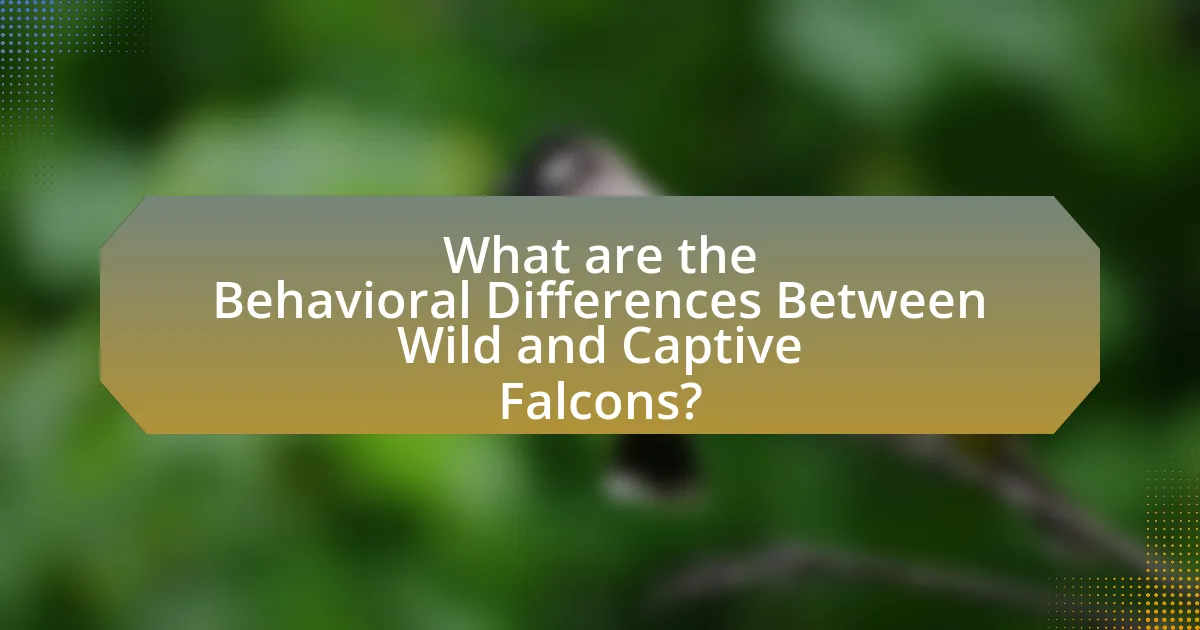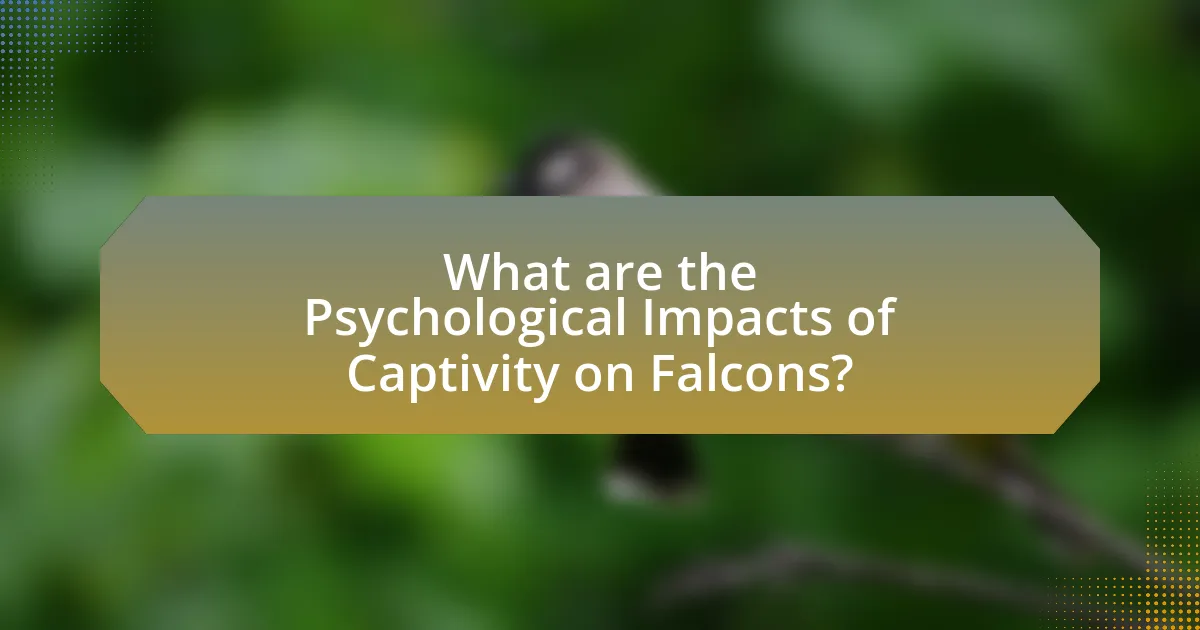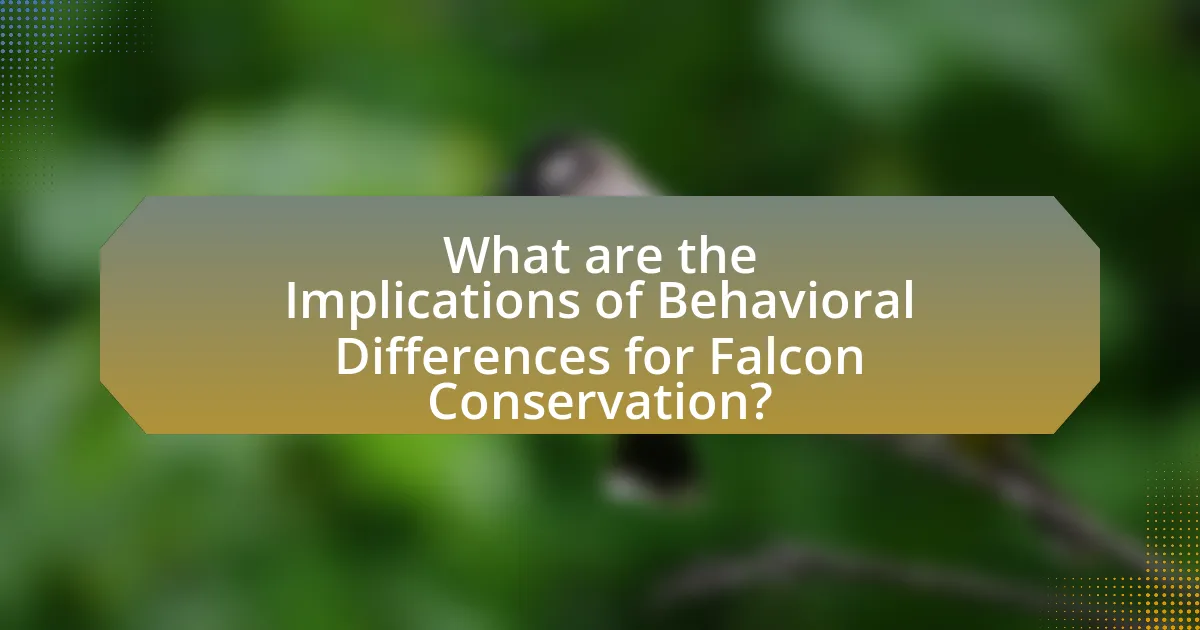The article examines the behavioral differences between wild and captive falcons, highlighting how natural instincts, social interactions, and hunting behaviors are altered in captivity. It discusses the influence of environmental factors on falcon behavior, noting that wild falcons adapt their hunting strategies based on prey availability and habitat conditions, while captive falcons often exhibit reduced hunting skills and abnormal behaviors due to confinement. The article also explores the psychological impacts of captivity, including stress and behavioral adaptations, and emphasizes the implications of these differences for falcon conservation efforts, particularly in rehabilitation and reintroduction strategies. Understanding these behavioral variations is crucial for improving the welfare of captive falcons and enhancing conservation practices.
What are the Behavioral Differences Between Wild and Captive Falcons?

Wild falcons exhibit natural hunting behaviors, social interactions, and territorial instincts that are often diminished or altered in captive falcons. In the wild, falcons engage in complex hunting strategies, relying on their keen eyesight and agility to catch prey, while captive falcons may rely on humans for food and lack the opportunity to develop these skills fully. Additionally, wild falcons establish and defend territories, displaying aggressive behaviors towards intruders, whereas captive falcons may show reduced territoriality due to confinement. Studies have shown that the lack of environmental enrichment in captivity can lead to abnormal behaviors, such as pacing or feather plucking, which are not observed in their wild counterparts.
How do environmental factors influence falcon behavior in the wild versus captivity?
Environmental factors significantly influence falcon behavior, with wild falcons exhibiting more natural hunting and social behaviors compared to their captive counterparts. In the wild, falcons adapt their hunting strategies based on prey availability, weather conditions, and habitat structure, which fosters instinctual behaviors essential for survival. Conversely, captive falcons often experience restricted environments that limit their ability to engage in natural behaviors, leading to altered social interactions and reduced hunting skills. Research indicates that captive falcons may develop stereotypic behaviors due to the lack of environmental enrichment, which is less common in the wild where they face dynamic challenges.
What specific environmental elements affect wild falcon behavior?
Specific environmental elements that affect wild falcon behavior include habitat type, prey availability, weather conditions, and human activity. Habitat type influences nesting sites and hunting strategies, while prey availability directly impacts feeding behavior and foraging patterns. Weather conditions, such as temperature and wind, can affect flight patterns and hunting success. Additionally, human activity, including urbanization and agricultural practices, can alter natural habitats and influence falcon behavior by increasing stress or reducing prey populations. These factors collectively shape the behavioral adaptations of wild falcons in their natural environments.
How does captivity alter the environmental conditions for falcons?
Captivity alters the environmental conditions for falcons by restricting their natural habitat and altering their behavioral patterns. In the wild, falcons experience a diverse range of environmental stimuli, including varying weather conditions, availability of prey, and opportunities for flight and hunting. In captivity, these factors are controlled and limited, leading to a more static environment that can affect their physical and psychological well-being. Research indicates that captive falcons often exhibit signs of stress and abnormal behaviors, such as pacing or feather plucking, due to the lack of stimulation and natural behaviors they would typically engage in in the wild.
What role does social interaction play in the behavior of wild and captive falcons?
Social interaction significantly influences the behavior of both wild and captive falcons. In the wild, social interactions among falcons, such as hunting cooperatively and establishing territories, enhance their survival and reproductive success. For instance, species like the peregrine falcon exhibit social behaviors during breeding seasons, where pair bonding and communication are crucial for nesting and raising young. In contrast, captive falcons often experience altered social dynamics due to limited interactions with other birds, which can lead to stress and abnormal behaviors. Research indicates that captive falcons may develop stereotypic behaviors when deprived of social interaction, highlighting the importance of social structures in their natural behavior. Thus, social interaction plays a critical role in shaping the behavioral patterns of both wild and captive falcons, affecting their well-being and adaptability.
How do wild falcons interact with their peers and environment?
Wild falcons interact with their peers and environment primarily through vocalizations, hunting behaviors, and territorial displays. These interactions are crucial for establishing social hierarchies and maintaining breeding territories. For instance, vocal calls serve as communication tools among falcons, signaling presence, distress, or readiness to mate. Additionally, during the breeding season, male falcons perform aerial displays to attract females and assert dominance over rivals, which is essential for reproductive success. Research indicates that these behaviors are influenced by environmental factors such as prey availability and habitat conditions, which can affect their social interactions and survival strategies.
What social structures exist among captive falcons?
Captive falcons typically exhibit social structures that are influenced by their environment and management practices. In captivity, falcons may form hierarchical relationships based on factors such as age, sex, and individual temperament. For instance, dominant individuals often assert control over resources like food and space, leading to a pecking order among the birds. Additionally, captive falcons may engage in social interactions that include vocalizations and displays, which can serve to establish or reinforce social bonds. Research indicates that these social dynamics can affect their overall well-being and behavior, highlighting the importance of understanding social structures in captive settings for effective management and care.
How does hunting behavior differ between wild and captive falcons?
Hunting behavior differs significantly between wild and captive falcons, primarily due to environmental factors and the availability of prey. Wild falcons exhibit instinctual hunting techniques, relying on their natural instincts to pursue and capture live prey, which enhances their physical fitness and survival skills. In contrast, captive falcons often have their food provided by humans, leading to a reduction in hunting behaviors and skills. Research indicates that captive falcons may display less agility and hunting proficiency compared to their wild counterparts, as they do not engage in the same level of physical exertion or practice necessary for effective hunting. This difference is supported by studies showing that wild falcons develop stronger hunting skills through regular interaction with their environment and prey, while captive falcons may become reliant on human intervention for sustenance.
What hunting techniques do wild falcons employ?
Wild falcons employ several effective hunting techniques, primarily including stooping, hovering, and pursuit. Stooping involves diving at high speeds from great heights to catch prey, which can reach speeds of over 200 miles per hour, making it one of the fastest hunting techniques in the animal kingdom. Hovering allows falcons to maintain a fixed position in the air while scanning for prey, enabling them to spot small animals from a distance. Pursuit involves chasing down prey on the ground or in the air, showcasing their agility and speed. These techniques are adapted to their environment and prey types, demonstrating their efficiency as hunters in the wild.
How is hunting behavior modified in captive falcons?
Hunting behavior in captive falcons is modified primarily due to the lack of natural prey availability and the controlled environment in which they are kept. Captive falcons often exhibit reduced hunting instincts and behaviors, as they do not need to hunt for survival, leading to a reliance on human-provided food. This alteration can result in decreased physical fitness and hunting skills, as captive conditions limit opportunities for natural hunting practice. Studies have shown that captive falcons may also develop behavioral issues, such as aggression or stereotypies, due to the absence of environmental stimuli that would typically trigger hunting behaviors in the wild.
What are the Psychological Impacts of Captivity on Falcons?

The psychological impacts of captivity on falcons include increased stress, abnormal behaviors, and reduced cognitive function. Captive falcons often experience heightened anxiety due to confinement, which can lead to stereotypic behaviors such as feather plucking or pacing. Research indicates that these stress responses are linked to the lack of environmental enrichment and natural stimuli found in the wild. A study by McGowan et al. (2016) published in the journal “Animal Welfare” highlights that captive raptors exhibit significant behavioral differences compared to their wild counterparts, emphasizing the importance of providing a stimulating environment to mitigate these psychological effects.
How does captivity affect the mental health of falcons?
Captivity negatively impacts the mental health of falcons by inducing stress and behavioral changes. Research indicates that captive falcons often exhibit signs of anxiety, such as feather plucking and aggression, due to limited space and lack of stimulation compared to their wild counterparts. A study published in the Journal of Avian Medicine and Surgery found that captive raptors, including falcons, displayed higher levels of stress hormones, which can lead to long-term psychological issues. These findings highlight the importance of environmental enrichment and proper care to mitigate the adverse effects of captivity on falcon mental health.
What signs indicate stress or discomfort in captive falcons?
Signs that indicate stress or discomfort in captive falcons include excessive vocalization, feather plucking, and changes in feeding behavior. Excessive vocalization often manifests as constant calling or screaming, which can signal anxiety or distress. Feather plucking is a physical manifestation of stress, where the falcon removes its own feathers, leading to potential injury and further discomfort. Changes in feeding behavior, such as refusing food or overeating, can also indicate stress levels, as captive falcons may react to their environment by altering their eating habits. These behaviors are well-documented in avian studies, highlighting the importance of monitoring captive falcons for signs of stress to ensure their well-being.
How can captive environments be improved for falcon welfare?
Captive environments can be improved for falcon welfare by enhancing space, providing naturalistic habitats, and incorporating enrichment activities. Increasing the size of enclosures allows for more natural behaviors, such as flying and hunting, which are essential for falcon well-being. Naturalistic habitats that mimic wild environments, including perches, varied terrain, and appropriate vegetation, support psychological health and reduce stress. Additionally, implementing enrichment activities, such as puzzle feeders and opportunities for social interaction, stimulates cognitive functions and encourages natural hunting behaviors. Research indicates that these improvements lead to better physical health and behavioral outcomes in captive raptors, as evidenced by studies showing reduced stress indicators and increased activity levels in enriched environments.
What behavioral adaptations do captive falcons exhibit?
Captive falcons exhibit several behavioral adaptations that differ from their wild counterparts, primarily due to their controlled environment. These adaptations include reduced hunting instincts, increased reliance on human interaction for stimulation, and altered social behaviors. For instance, captive falcons may show less aggression and territoriality, as they are not competing for resources in the wild. Additionally, they often develop a dependency on humans for food and enrichment, leading to changes in their natural foraging and hunting behaviors. Studies have shown that these adaptations can impact their overall health and well-being, as captive environments limit their ability to engage in instinctual behaviors such as hunting and nesting.
How do captive falcons develop coping mechanisms?
Captive falcons develop coping mechanisms primarily through environmental enrichment and social interaction. These strategies help mitigate stress and adapt to the limitations of captivity. Research indicates that providing varied stimuli, such as toys, perches, and opportunities for flight, enhances their mental well-being and reduces stereotypic behaviors. Additionally, social interactions with humans or other birds can foster a sense of security and reduce anxiety, as evidenced by studies showing improved behavioral outcomes in captive raptors exposed to socialization.
What behaviors are commonly observed in captive falcons that differ from their wild counterparts?
Captive falcons exhibit behaviors that significantly differ from their wild counterparts, primarily due to the constraints of their environment. In captivity, falcons often display reduced hunting instincts and less aggressive behaviors, as they are typically fed by their handlers rather than hunting for food. This reliance on humans can lead to decreased physical fitness and altered social interactions, as captive falcons may not engage in the same territorial displays or mating rituals observed in the wild. Additionally, captive falcons may show signs of stress or boredom, such as feather plucking or repetitive movements, which are less common in their natural habitats where they have more opportunities for stimulation and natural behaviors.
What are the Implications of Behavioral Differences for Falcon Conservation?

Behavioral differences between wild and captive falcons significantly impact falcon conservation efforts. Wild falcons exhibit natural hunting and social behaviors that are essential for their survival and reproduction, while captive falcons often display altered behaviors due to limited space, lack of natural stimuli, and human interaction. These behavioral changes can lead to challenges in reintroducing captive-bred falcons into the wild, as they may lack the necessary skills to hunt or interact with wild populations effectively. Research indicates that captive falcons may develop dependency on human-provided food, which undermines their ability to thrive independently in natural habitats. Understanding these behavioral differences is crucial for developing effective conservation strategies that ensure the successful integration of captive falcons into wild ecosystems.
How do behavioral differences impact conservation strategies for falcons?
Behavioral differences between wild and captive falcons significantly impact conservation strategies by necessitating tailored approaches for each group. Wild falcons exhibit natural hunting and social behaviors that are crucial for their survival and reproduction, while captive falcons may develop altered behaviors due to limited space and human interaction. For instance, research indicates that captive falcons often lack the skills needed for effective hunting, which can hinder their reintroduction into the wild. Consequently, conservation strategies must include behavioral training and enrichment for captive falcons to ensure they can adapt to their natural environments upon release. This tailored approach is supported by studies showing that successful reintroduction programs, such as those for the Peregrine Falcon, incorporate behavioral conditioning to enhance survival rates in the wild.
What considerations should be made when rehabilitating captive falcons for release?
When rehabilitating captive falcons for release, it is essential to consider their behavioral differences compared to wild counterparts. Captive falcons may lack essential hunting skills, social behaviors, and survival instincts that are critical for thriving in the wild.
To address these gaps, rehabilitation programs should focus on providing training that mimics natural hunting scenarios, allowing falcons to practice and develop their predatory skills. Additionally, socialization with other raptors can help restore natural behaviors and improve their adaptability.
Monitoring the falcons’ health and ensuring they are physically fit for release is also crucial, as malnutrition or illness can hinder their chances of survival post-release. Research indicates that successful rehabilitation often includes a gradual acclimatization process to the wild environment, which helps the falcons adjust and reduces stress during the transition.
How can understanding falcon behavior improve conservation efforts?
Understanding falcon behavior can significantly enhance conservation efforts by informing habitat management and breeding programs. By studying the hunting patterns, nesting habits, and social interactions of falcons in the wild, conservationists can create environments that mimic natural conditions, thereby increasing the success rates of reintroduction programs. For example, research has shown that captive-bred falcons often struggle to adapt to wild conditions due to a lack of learned behaviors essential for survival. Implementing training programs that simulate wild experiences can improve their chances of survival post-release. Additionally, understanding the impact of environmental changes on falcon behavior allows for targeted conservation strategies that address specific threats, such as habitat loss or food scarcity, ultimately leading to more effective protection of these birds in their natural habitats.
What best practices can be implemented for the care of captive falcons?
Best practices for the care of captive falcons include providing a spacious and enriched environment, ensuring a balanced diet, and facilitating regular exercise. A spacious enclosure allows falcons to exhibit natural behaviors, while environmental enrichment, such as perches and hiding spots, stimulates their mental health. A balanced diet, typically consisting of whole prey or high-quality commercial diets, is essential for their nutritional needs. Regular exercise, through activities like free flight or lure training, helps maintain their physical condition and mimics their natural hunting behaviors. These practices are supported by avian care guidelines from organizations like the Association of Avian Veterinarians, which emphasize the importance of meeting the physical and psychological needs of captive birds.
How can handlers create a more naturalistic environment for captive falcons?
Handlers can create a more naturalistic environment for captive falcons by incorporating elements that mimic their natural habitat, such as providing perches at varying heights, offering natural substrates like grass or soil, and ensuring access to sunlight and shade. These modifications help to reduce stress and promote natural behaviors, as studies have shown that environmental enrichment can significantly improve the well-being of captive birds. For instance, research indicates that falcons exposed to a more naturalistic setting exhibit increased activity levels and engage in behaviors similar to those observed in the wild, such as hunting and social interactions.
What training techniques are effective for maintaining natural behaviors in captive falcons?
Effective training techniques for maintaining natural behaviors in captive falcons include the use of positive reinforcement, environmental enrichment, and flight training. Positive reinforcement, such as rewarding falcons with food or praise for desired behaviors, encourages natural hunting and foraging instincts. Environmental enrichment, which involves providing varied stimuli and opportunities for exploration, helps simulate a wild habitat, promoting natural behaviors like perching and hunting. Flight training, where falcons are encouraged to fly freely in a controlled environment, allows them to exercise their wings and engage in natural flight patterns. These techniques have been supported by studies indicating that captive falcons that receive such training exhibit behaviors more akin to their wild counterparts, thereby enhancing their overall well-being.


